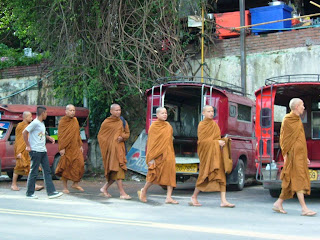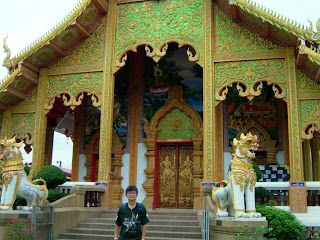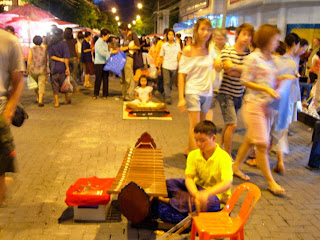
Chiang Mai, formerly named as Lanna, is the largest and most significant city in Northern Thailand. It was a former capital of Kingdom Lanna within 1268-1768 and was the tributary Kingdom of Chiang Mai from 1774-1939. Chiang Mai which means New City was founded by King Mengrai on the location of an old city of Lawa people. It replaced and succeeded Chiang Rai to become the new capital for Lanna Kingdom in year 1296 . The city sitting among the highest mountains in the country about 700km away from Bangkok, is along the Ping River which is the major tributary of Chao Phraya River. The historic importance is derived from its close proximity from Ping River to major trading routes. Chiang Mai being long terms threatened by its neighboring countries Burma and Mongal Empire, officially became part of Siam in 1775 by an agreement with Chao Kavila when Thai King Teksin helped to drive out Burmese. Chiang Mai slowly grew into cultural, trading and economic importance to its current statues. Today it attracts more than a million of foreign tourists a year.
Many Westerners as we know, love sunshine and sand beaches but surprisingly, groups of them are found gathering in this mountainous city- Chiang Mai. They stay for weeks or even months, reluctant to leave. I communicated with some of the youngsters from America, Europe, Canada, Australia and they are basically like me, fall in love with its peaceful comfortable environment. Though it is religious, but is a place where we can afford to pamper ourselves.


Chiang Mai is a place of merits and virtuous as people living here are able to practice "giving", offering food to Buddhist Monks who come out early at dawn with alms for them to gather good merits.


Thailand is a Buddhist country and practicing Pindapata, offering food to monks is the Buddhist traditions to gather merits. All Theravada monks only eat food that are offered to them and they take only one meal a day before noon.



Thailand encourages every male to leave home at least once in a life time for few weeks to few years to experience the left-home life. Those newly left home teenage are called "sami" and elder monks are addressed as Bhikshu. All monks lead the same daily life, get up before 4am, one meal a day before noon and practice meditation and chanting.




Received blessing after life liberation.



We met Shari and Evan, the Canadian couple when visiting Wat Phrathat Doi Suthep. Doi Suthep is the name of the Hill where The Temple located. The Temple is said to be founded in 1383 when the first Chedi was built and over time, expanded with many more holy shrine halls making the complex look more extravagant. The temple complex now consists of 4 main holy shrines, museum, residences for monks and guests with a multiple purposes building.


The original copper plated Chedi at Doi Suthhep is the most holy area of the temple grounds.




Wat Doi Suthhep is a sacred site to many Thai people. According to legend, about 600 years ago, there was a monk from Sukhothai named as Sumanathera found a Buddha's shoulder bone relic in a place called Pang Cha after having a dream. He offered the relic to the King who was doubtful about the characteristic of the relic and returned it to him. King Nu Naone of Lanna Kingdom heard about it and requested for it. The relic apparently split into two in which one remained the same size and the other smaller. The King enshrined the smaller one at a temple at Suandok and the other one, he placed it on the back of an white elephant and released it in the jungle. The elephant was said to be climbing up Doi Suthep Hill and died after he trumpeted 3 times on the site. It was interpreted as a sign for the King Nu Naone to order the construction of the temple at the site.



The auspicious Buddha Images at some of the holy shrine halls.



After offering our highest respect with lotus flower and incense to Pagoda where Buddha's bone relic was kept, we received blessing from monk at Dot Suthep Temple.


Faith is with us.



It was believed that the first temple of Wat Doi Suthep was constructed at this location where the white elephant which carried on his back a Buddha's bone relic trumpeted 3 times at the site, before it died.


It was said that the jack fruit tree grown up by the side of white elephant status and the shrine hall never failed to prosperously bear fruits through out the year.




Chiang Mai surrounded by nature hills and water has a history of 700 over years. It was built on a traditional heritage of Lanna Empire and its greatly influenced by Buddhism. Temples appear in all parts of the city, different construction year, different design, different carving with individual story, but all look adorable and artistic. To understand more about Chiang Mai's past the best way is to visit temples at different corners.



The aspects of Wat Doi Suthep draw from both Buddhism and Hinduism with pagodas, statues, shrines and bells at site. The huge gold-plated bell for the auspicious Buddhist Center of Chiang Mai was contributed by a Malaysian Buddhist, Saddhu, Saddhu, Saddhu!



The mythical snakes, the naga were built in length along the stairway of 309 steps to reach the pagodas and main entrance of Doi Suthep Temple first shrine hall.


The golden entrance to the main shrine hall of Dot Suthep Temple and visiting monks .



Doi Suthep Hill offers superb views over the city.. The city's emblem depicts Chedi at Wat Doi Suthep in its center as the naga, the mythical snakes are said to be the source of Ping River and the rice stalks representing fertility of the city.



Lychee plants blossom with red fruits and the tradition costumes shop at mountainous tribes village of Doi Suthep Hill.


Wat Rong Khun along the main road to Chiang Rai is a work of art. The temple is stark white and incredibly ornate. White Plaster everywhere symbolizes Buddha's purity and pieces of glass chips stuck all over, represents Buddha's wisdom. The construction of the structure began in year 1997 and was grandly opened recently by King of Thailand.


The structure combined an eclectic mix of traditional Buddhist imagery with modern symbols was highly controversial.




Wat Rong Khun Temple is very uniquely designed with forces of good and evil existed inside the temple, where beauty and humanity of Buddhas on the wall and some of the superficiality of western culture on the other side.



An extraordinary temple where old meets new!







Temple is entered by a bridge over a sea of demons skulls grasping hands representing the transition via hell from earthly existence to Nivana.



Wat Bupparam was founded in year 1497 by King Muang Kaew but The Burmese styled Chedi at the site was rebuilt in year 1958 .


The shrine hall Hor Monthientham with pinnacled roof at Wat Bupparam is completed in year 1996 after 10 years construction. It was built on the spot where an earlier wooden structure used to stand and is the newest building at the site.



The world largest teak-wood Buddha image stands high in the main shrine of Wat Bupparam Temple. A monk was bowing to all Buddha images. Kneel and bow full mindfully with forehead, elbows, hands touching the floor is the usual way for a Buddhist to show respect to Buddha, to make repentance and reduce bad karma. The Green Jade Burmese Buddha Image Wat Bupparam Temple houses at shrine hall, is one of the two famous historical jade Buddha from Burma left in the world. The other white Jade Buddha is presently displaced at "Temple Yu Fo Si" of Shanghai .



The colorful and attractive teak-wood ceiling with murals inside the main shrine in Wat Bupparam exhibit the beautiful architectural of Wat Buppaple. It is a fine demonstration of contemporary religious art.



The two storey Hor Monthientham surrounded by statues of guardian creatures is a mixed styled with no architectural significance. The Lanna style Viharn contains a large brick and stucco Buddha has 300 years in history but today it looks probably originates from a restoration at the end of 19th century.






Wat Chetawan Chedi and Viharn.



Wat Chetawan and Wat Mahawan.




Wat Tung Yu Monastry (1260-1578)



Wat Tung Yu monastery had been in existence since the time of Mang Rai Dynasty (1260-1578)


The beautiful gilded wooden door at Wat Chai Prakiat.




Wat Phra Singh Temple situated within the old walled city emphasizes on meditation and till today it still continues giving lessens on meditation courses. The Temple houses a high venerated Phra Singh Buddha Image.



Wat Phra Singh Temple was built with classic northern style architecture of Thailand in 1345.


Wat Chadi Luang situated at the historic center of Chiang Mai City is one of the oldest temple in the city. In year 1545, the upper 30 m of the structure collapsed after an earthquake and the auspicious Emerald Buddha Image installed at eastern niche in year 1468 was removed 6 years later to Luang Prabeng. The temple was reconstructed in 1993 with finance aided by UNESCO and Japan Government but result was controversial as new elements were in Central Thai style instead of Lanna style. It was not permitted to go up the building due to some renovation but big meal offerings plus chanting session were carried on by the side of building.


Wat Chadi Luang temple complex consists of 3 temples namely Wat Chadi Luang, Ho Tham and Wat Sukim, started building in 14th century by King Saen Muang Ma who initially planned to construct the building for burying his father's ashes but 10 years later until he died, the temple was not completed. His wife followed up with the project. The temple was finally completed during the reign of King Tikokarey in mid 15th century. It was the largest building at Lanna period with a base diameter of 54 meter by 82m high.




Temple Wat Suan Dok, built in 14th century house the 500 years old bronze Buddha Image, which is one of the largest metal images in the country.



The white Chedis around the temple contains ashes of Chiang Mai's royal family.



No cement, no concrete, sleeping under this little teak-roofing hut, surrounded by hills, filling with river flowing rhythm, with insects orchestra entertainment every night, fully embraced by the nature, what else you want more in this world? Our little cottage house in Chiang Mai Hill Resort.


A peaceful place for our soul and body to relax and relieve.











The decoration and service of the only restaurant at the resort was quiet good but unfortunately the food provided was not too "Thai".



The only traffic in the morning was the elephants.



The teak roofing of the cottage houses!



As comfortable as home at Chiang Mai ! with home cooked food the staff bought from us from the local home, we nearly forgot our own home.


Morning market at Chiang Mai - The 17th century Chinese migrant fruit -Lychee - today is one of the leading crops of Chiang Mai earning great export income for the city. Its pink skin with juicy sweet flesh always is the attraction of Asian food lovers. During the season, Lychee tree hanging with bundles of red fruits could be seen any where and ripen fruits were in sales at every corners together with their traditional fresh local herbs.



The night bazaar located at the old historic center of the city, sprawls along several commercial blocks along the sideways, inside the buildings, covers all open squares and empty ground area inside temples, offering food, wears and entertainments.


After hours of strolling in the bazaar, tensed, tired, soreness....do not hesitate, sit down and let the Thai lady relax and release for you at any hour any corner of the streets for any minutes you need. Their pair of soft hands will tenderly therapy over your skin and nerves, relaxing your body and soul.



Some activities at night bazaar.



Papaya salad and mango rice are two of the most favorable Thai appetizers and desert many people love . A big round green papaya and Thai grown sticky glutinous rice are the most important element to make these two popular dishes wonderful.




No one can ever stand the temptation of its "Pad Thai""Radna""Pad See Ew" fried noodles, Tomyum Kung spicy sour prawns soup, durian and mango glutinous rice, papaya salad and those fresh mushroom, herbs, soft red wild rice and wide varieties of its seasonal fruits.


Huge varieties of sweet desert made from fruits, vegetables in different design and shape are attractively decorated in the store.




Thai food uses wide variety of sauces to create aroma in their hot and sour food and the disgusting roasted creepy crawlies and insects, especially the giant sized water bugs. Insects are one of the north east Thai common snack food consumed for protein absorption..



The historic moat and defensive surrounded the city was built for defense as the neighbor Burma was a constant threat in the past.



Chiang Mai International Airport.


The city of Chiang Mai is subdivided into 4 wards with Nakhon at north, Srivijaya at west, Mengrai at south and Kawila at east side of the river. Basically water is running through the four directions of the city thus giving kind of temperate climate to the area and provide a fertile land for nature production.




No comments:
Post a Comment